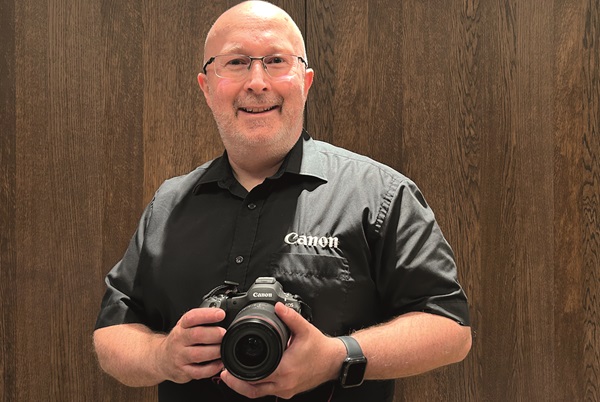Last month, Canon unveiled the EOS R1 and EOS R5 Mark II mirrorless cameras in Munich before a gathering of camera enthusiasts and press. BroadcastPro ME interviewed Mark Fensome of the Canon Europe Pro Video, Broadcast and Displays division to discuss the features and innovations that set the R5 Mark II apart from its predecessors and competitors.
Canon’s R5 Mark II mirrorless camera has caused a stir among independent filmmakers. Building on the success of its predecessor, it introduces features tailored to both seasoned professionals and indie content creators. According to Canon, the camera’s new design and feature set stem from user feedback.
“One key focus was improving the synergy between the R5 Mark II and our cinema range, like the new C400 and other older cameras,” says Mark Fensome. “We wanted to ensure that files from different cameras like the R5 Mark II and the C400, or even older cameras, are compatible and consistent. This compatibility simplifies data management and editing, especially in multi-camera set-ups for content creation or broadcast.”
Another major consideration was the bitrates and resolutions offered by the camera. Fensome pointed out that while the original R5 was capable of high bitrates and 8K video at 60 frames per second, it might be a bit of overkill for some projects.
“While 8K at 60 frames per second is great for VR – especially with our VR lens that requires high resolution – we’ve also added options for lower bitrates,” he explains. “For broadcast, you might prefer 4K or even full-HD resolutions with high frame rates.”

This flexibility extends to slow-motion recording as well. The R5 Mark II offers 4K RAW at 120fps and full HD at 240fps, which he describes as “ideal for capturing those dramatic slow-motion effects, making the camera versatile for different shooting scenarios”.
One standout feature is the R5 Mark II’s VR capability. Canon has developed a dual fisheye VR lens specifically for this camera.
“The lens has two front-facing lenses spaced 60mm apart, similar to human eyes. This set-up captures a very realistic 3D view with a 190-degree field of view, which is then output as a 180-degree VR image. What’s great about this system is that it uses just one sensor to capture both images, meaning there’s no need to worry about aligning two cameras,” comments Fensome.
“A single sensor ensures perfect synchronisation and eliminates colour or balance issues that can occur with separate sensors. The camera’s VR set-up significantly reduces complexity, making it easier to achieve high-quality VR content.”
Once the VR footage is captured, Canon’s EOS VR Utility software takes over and automatically processes the dual fisheye images into a single VR-ready file. “You can make some adjustments during this process, and if you’ve shot in RAW you’ll have the full dynamic range to work with,” he adds. The final output can be integrated into VR headsets or imported into video editing software like Adobe Premiere.
The R5 Mark II offers a wide range of file formats, including RAW, SRAW and Light RAW, catering to different postproduction needs. Canon also addresses a common concern about metadata in MP4 files by introducing the XF HEVC and XF AVC S formats, which include metadata for better organisation and editing. This feature is particularly beneficial in postproduction, where detailed information about footage, such as camera used and clip number, is crucial, says Fensome.
Broadcast professionals will appreciate that the R5 Mark II supports News metadata. “This means you can specify the metadata that gets written into each video file,” Fensome says. “When these files are brought into an editing suite, all the necessary metadata is already embedded, streamlining the editing process.”
The camera’s dual card slots – one for CFexpress and one for an SD card – offer flexible storage options, which Fensome says are consistent with the Cinema EOS line. “This helps when you need to manage storage space while still maintaining high video quality.”
We were also introduced to other innovations in a master class. One technical highlight of the camera was Canon’s new Accelerated Capture imaging platform, featuring the DIGIC Accelerator and DIGIC X processors. This dual-processing system boosts speed and responsiveness, enabling the capture of fast-paced action with greater precision and clarity.
Another important tech feature is the integration of Deep Learning advancements which refine the camera’s autofocus system, improving subject tracking even in dynamic environments. Whether it’s a fast-moving subject or a complex scene with multiple elements, the R5 Mark II’s intelligent AF system enables filmmakers to capture critical moments with accuracy.
For videographers concerned with extended shooting sessions for events and live streaming, Canon has introduced a cooling fan grip specifically designed to prevent overheating during prolonged use. Paired with the new high-performance LP-E6P battery, it can withstand the demands of long, continuous shoots.
In terms of video production, the camera’s support for Canon Log 2 and Log 3 expands the creative possibilities in post. These log profiles offer greater flexibility in colour grading, making it easier to achieve the desired look and feel for a project. Combined with the ability to record proxies and maintain industry-standard file naming, the R5 Mark II seamlessly integrates into professional workflows.
As we wrap up, Fensome shares his final thoughts on the R5 Mark II. He deems it highly versatile, equally useful for creative storytellers, hybrid users, independent filmmakers and small production teams.
“It is suitable for a wide range of applications, from wildlife shoots to weddings, event coverage, filmmaking and news reporting. The R5 Mark II is the next step forward for Canon, offering big improvements and new features that will enhance the shooting experience. It directly addresses the needs and feedback from the filmmaking community, making it a powerful tool for various content creation scenarios.















































































